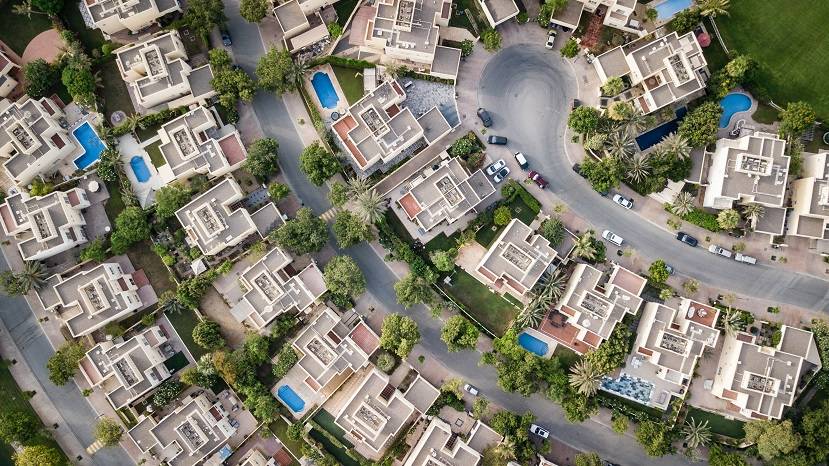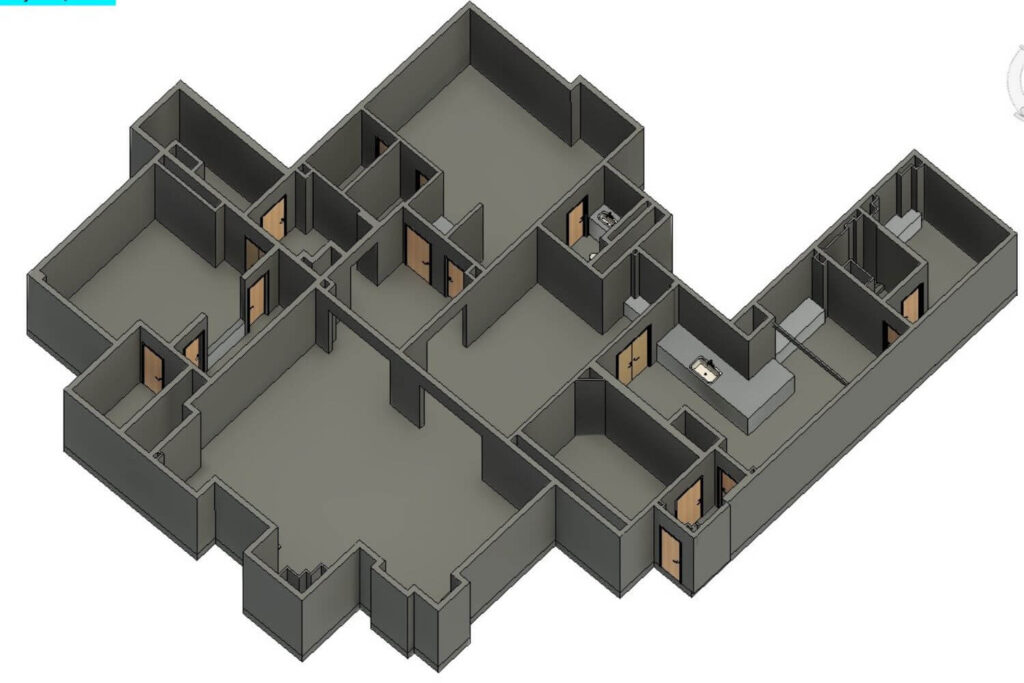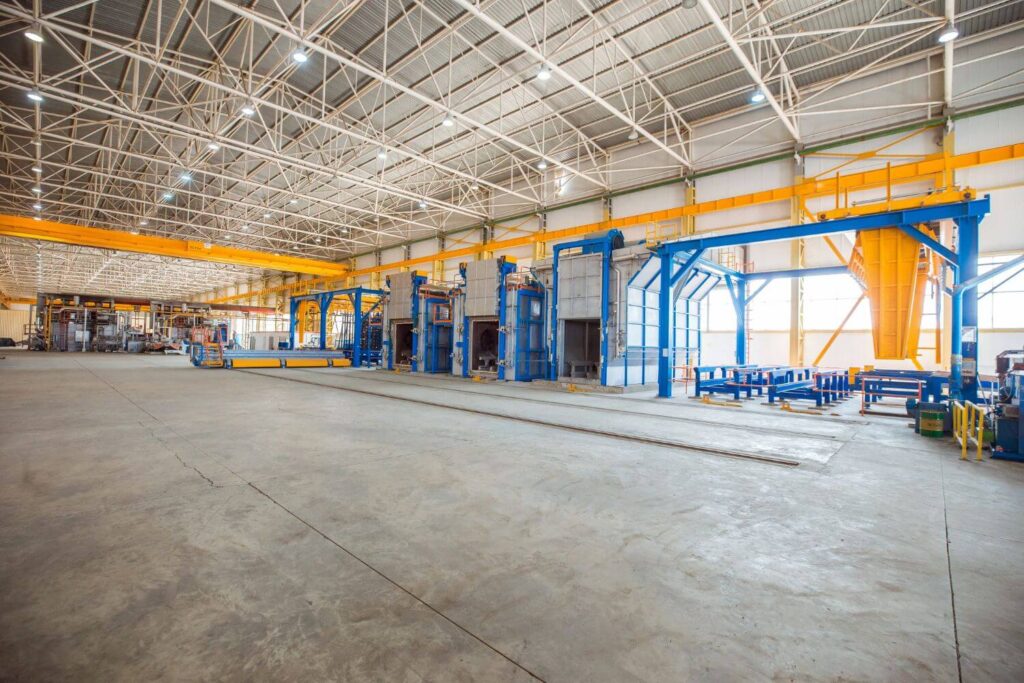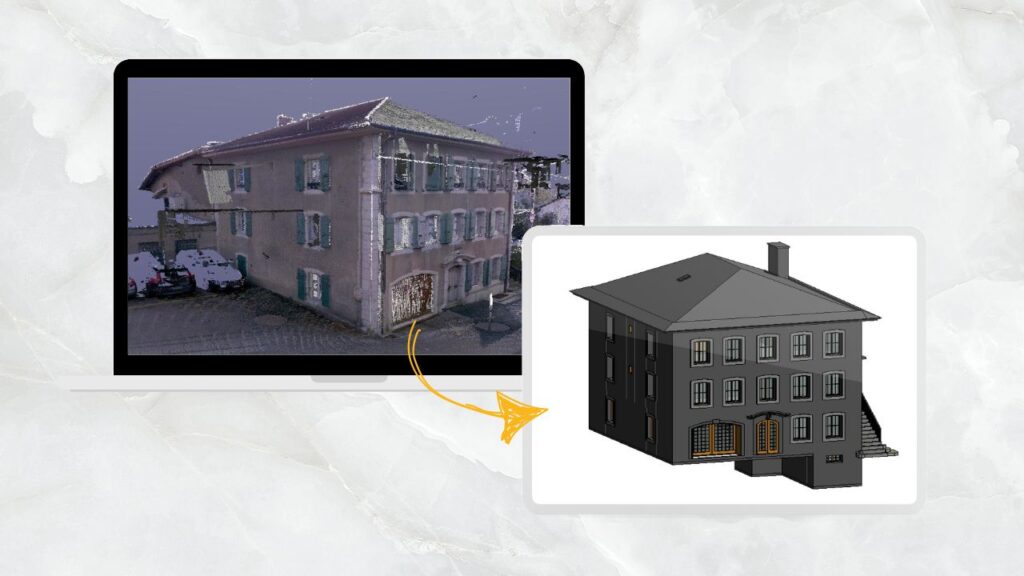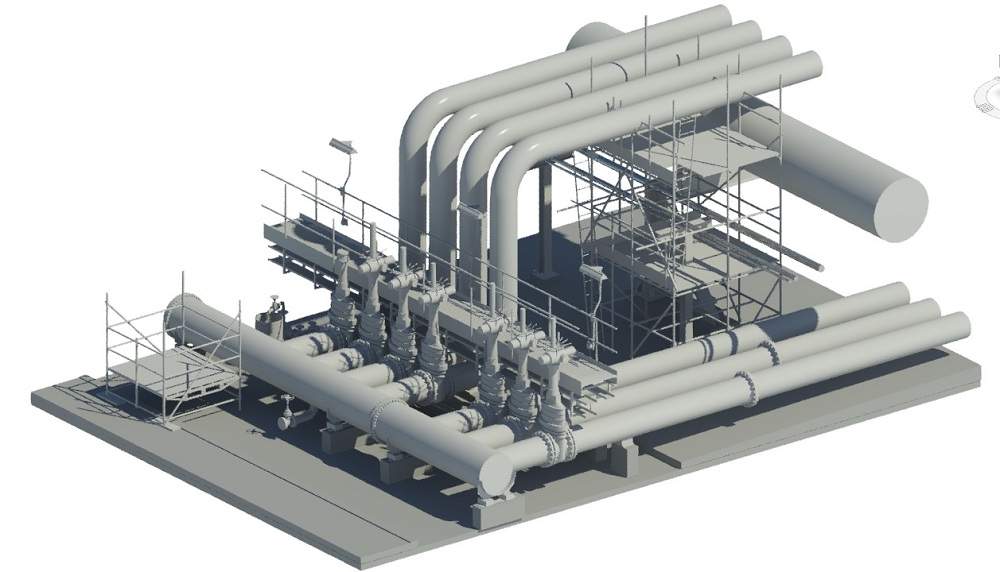Get in touch with CRESIRE to Convert Point Cloud to 3D Model Revit – The most efficient method for Surveyors, Architects, Engineers, and contractors!
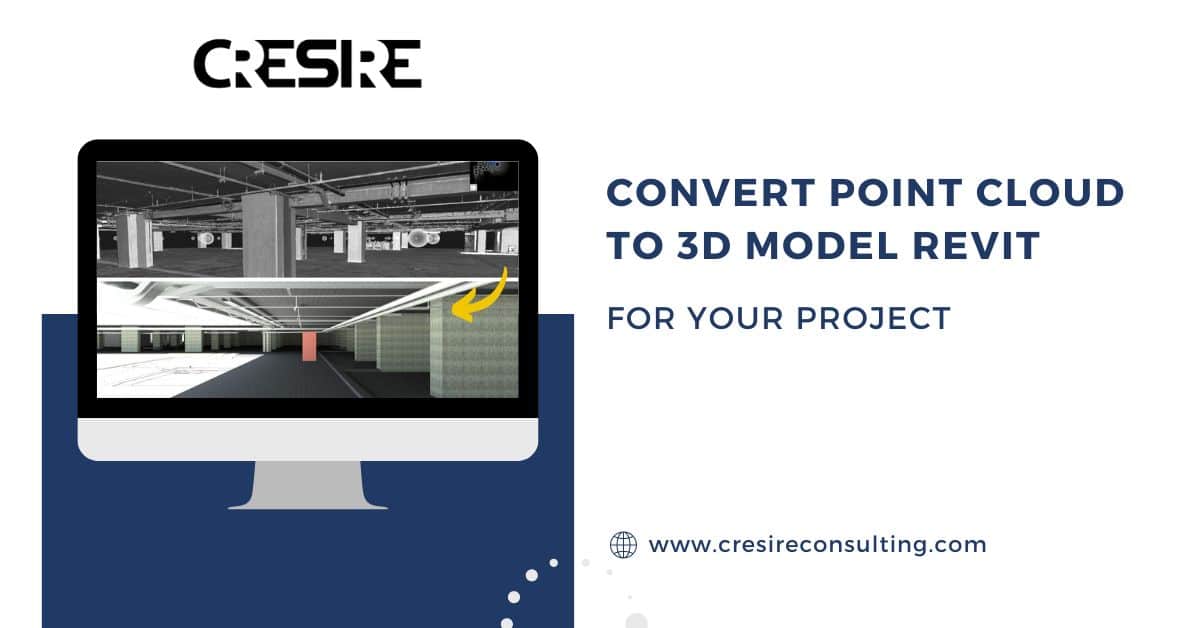
What is Point Cloud?
Point cloud is a 3D description of data/dots that builds a 3D picture of a space or a building. These points are captured by specialized cameras or laser scanners.
Point clouds represent precise location, and often the color of everything the scanner captures on a construction site or building.
Point clouds are used in the construction industry to capture the current state of buildings for renovation and facilities management.
See below a breakdown explanation of point cloud:
- A point cloud is a collection of data points with X, Y, and Z coordinates in a three-dimensional space. The points collectively represent the surface of a building and elements on site
- There are two ways to develop point clouds; special 3D scanners and photogrammetry
- 3D scanners use lasers to measure millions of points Each point carries extra information beyond its location. It often includes color data to create realistic 3d image
- Point clouds have diverse applications. In the AEC industry, point clouds are used for developing 3D BIM models in Architectural, Structural, and MEP industries.
- These BIM models are powerful for holding critical design and facilities information for carrying out potential future renovations and facilities management.
Reasons to Adopt BIM for Construction Management and Planning
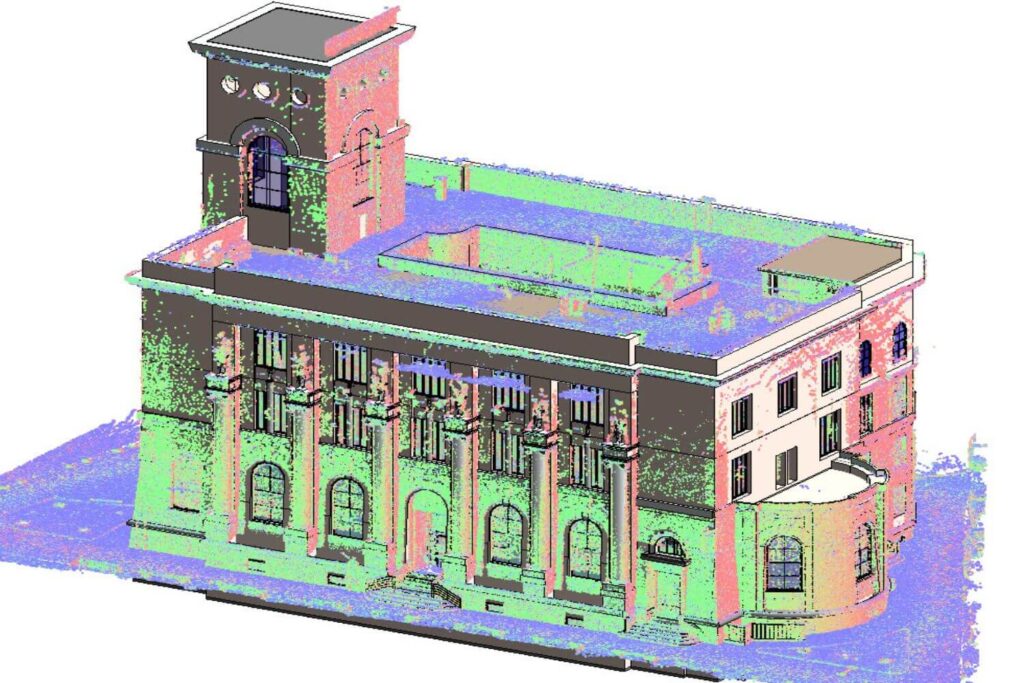
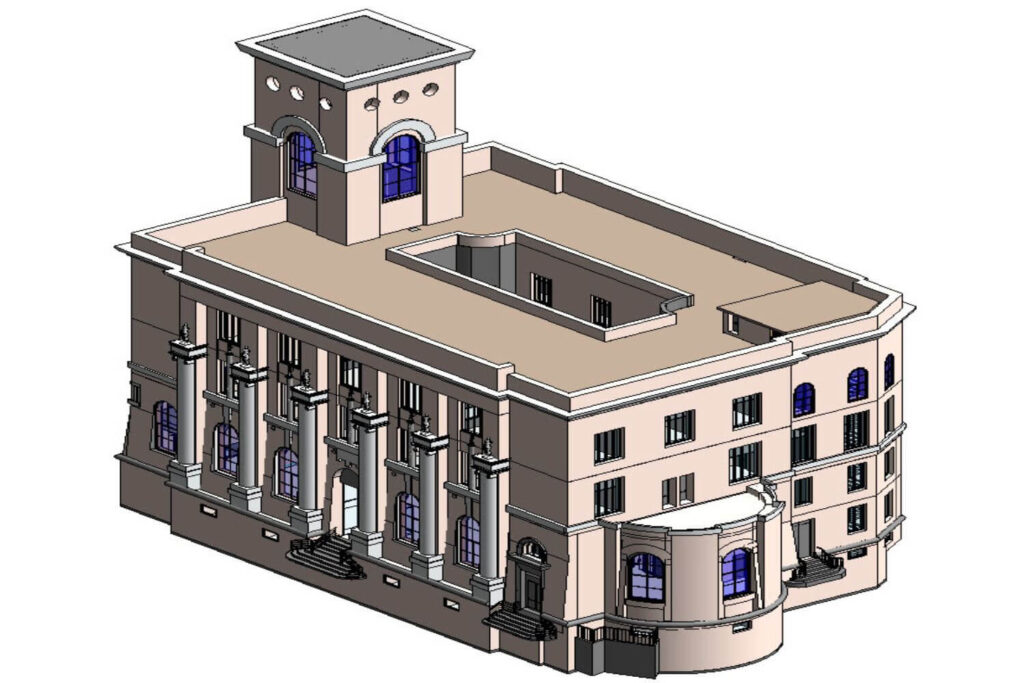
The biggest challenge for the construction industry is cost and time overrun. As per the studies, 70%-85% of construction megaprojects around the world experience cost and time overruns.
The main factors contributing to cost and time overruns include:
- Design errors.
- Design changes.
- Lack of coordination amongst project stakeholders.
- Lack of collaboration.
- On-site delays.
Now, let’s discuss how building information modeling (BIM) helps AEC professionals and project stakeholders overcome the challenges:
1. Avoiding Multiple Design Changes
Adopting BIM for construction management and planning includes adopting BIM practices right from the design stage.
Using BIM right from the conceptual stage allows project stakeholders to integrate the critical design elements details into the 3D Model.
The 2D CAD drawings can be directly extracted from the 3d Revit model. This allows project stakeholders to collaborate effectively and reduce the production/revision time of the engineering and architectural drawings.
2. Reducing Cost and Time Overruns on Site
Once the design is finalized, project managers integrate the project timeline into these 3D models to simulate the construction activities as per the Gantt chart; this is commonly known as 4D scheduling.
4D Scheduling is a powerful tool for construction managers to assess and plan site risks and activities, leading to reduced cost and time overruns on site.
3. Avoiding Delays via Advanced Collaboration
The project managers often face delays due to a lack of coordination and collaboration amongst the design stakeholders.
BIM promotes advanced cloud-based collaboration tools, i.e., BIM 360, that allow design stakeholders to upload their BIM models in IFC format. These IFC BIM models are accessible to all the project stakeholders added to the BIM 360 platform.
The stakeholders can review the critical design information, walk through the model, rotate, and leave their comments. This promotes high-level collaboration among project participants and helps them save significant Cost and Time for redesigning.
4. Eliminating the Risk of Design Errors
Design errors lead to major construction costs and time overruns. This occurs when the architectural design is not well coordinated with MEP and Structural design.
Construction managers often identify the clashes on site that lead to redesign, demolition, and re-construction of building elements. Using the clash detection feature in BIM for construction management and planning,
AEC professionals can identify these conflicts amongst the design elements, assign these risks to the respective design stakeholders, and eliminate these clashes before a project goes on site. This leads to significant cost and time savings for a construction project.
What is the Importance to Convert Point Cloud to 3D Model Revit?
The conversion of Point Cloud Data to 3D Model Revit is commonly referred to as Point Cloud to BIM Conversion or Point Cloud to Revit Model Conversion.
This process involves translating millions of data points into a comprehensive digital representation for use within BIM workflows.
- With the introduction of Point Cloud technology and the conversion of Point Cloud data to 3D Models like BIM, the construction sector has evolved greatly in the age of digitization.
- Using laser scanning technology, point cloud data can be efficiently converted into a precise 3D Revit model, providing an accurate digital representation of the scanned space or building
- Point cloud modeling uses millions of data points and high-resolution imagery captured through laser scanning to generate precise 3D BIM models for the architectural, structural, and MEP disciplines.
- Point Cloud Modeling Services, integrated with BIM workflows, enable the conversion of Point Cloud to 3D Model Revit. This facilitates the documentation of as-built design data and expedites quantity take-offs, enhancing project efficiency.
- Construction site assessment, renovation planning, redesigning, design verification, design assessment, cost estimation, facilities management, and As Built Drawings are some applications of the Point Cloud to Revit model.
“While Point Cloud Data provides a valuable collection of individual data points captured by laser scanning, it doesn’t directly represent a 3D model. To create a precise and information-rich 3D Model, CRESIRE uses point cloud data for developing a mesh – a collection of interconnected polygons that defines the surface geometry before developing a 3D Revit Model.”
What are the Advantages of Convert Point Cloud to 3D Model Revit?

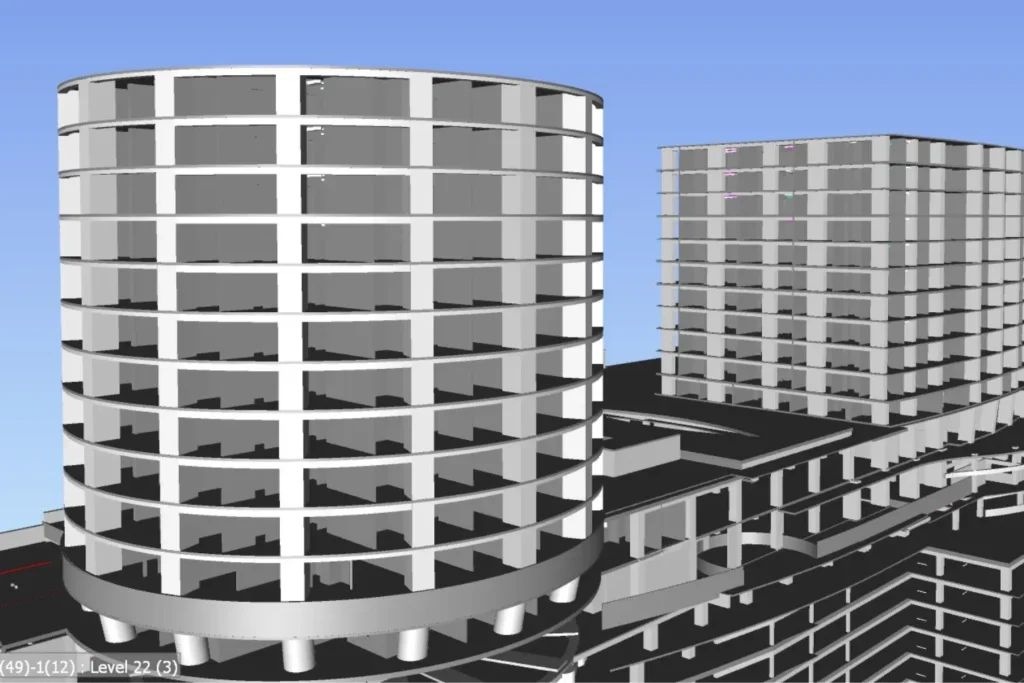
1. Design Precision
Field-based laser scanning using advanced scanners yields highly accurate results. The point cloud can be accurate to 1 to 30 centimeters.
Point cloud modeling offers a significant advantage for 3D modeling of locations and landscapes. Compared to traditional methods, it delivers superior accuracy and faster turnaround times.
2. Efficient Data Processing
Using point cloud registration platforms such as Recap Pro eliminates the need for manual triangulation.
Recap Pro automates information manipulation that saves significant hours. This efficiency allows you to dedicate more time to crucial project aspects like data acquisition and 3D Revit modeling, ultimately accelerating project completion.
3. Contributing to Saving Cost Overruns
Adopting the Point Cloud to 3d Revit model services leads to design accuracy that translates to more effective cost management (5D BIM), facilities management (6D BIM), and clash detection using precise 3D Revit Models.
You can visualize and assess the implications of the built asset and minimize risks and unforeseen expenses before the project goes on-site.
4. Enhanced Safety with Point Clouds to BIM
Traditional surveying methods can expose surveyors to physically access the site which can be dangerous, especially in the areas with steep slopes, uneven terrain, and unstable ground.
Through laser/drone scanning, data is captured remotely using lasers, eliminating the need for the surveyors to enter the risky areas. This reduces the chances of potential accidents and injuries.
What are the Suitable Formats of Point Cloud Data for Revit Modeling?
Revit supports various Point Cloud File Formats for importing into BIM Models. Below are some common suitable options:
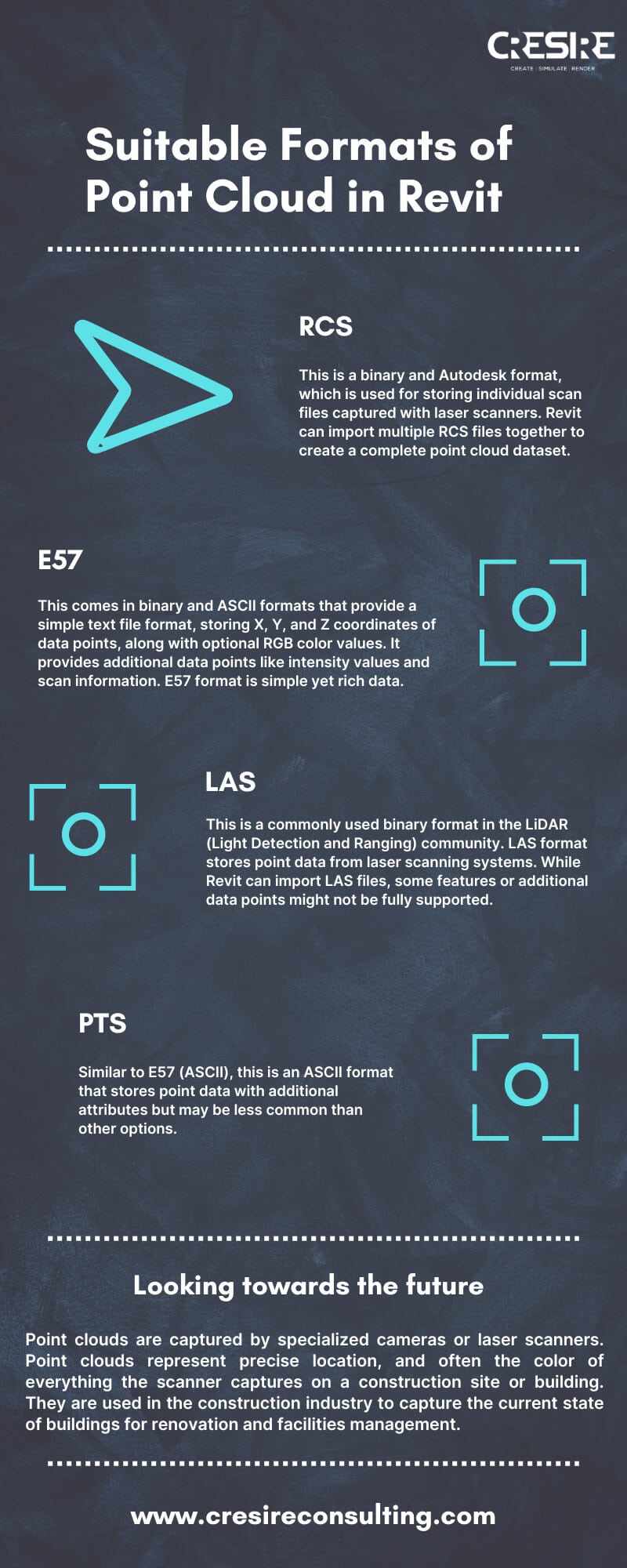
1. RCS
This is a binary and Autodesk format, which is used for storing individual scan files captured with laser scanners. Revit can import multiple RCS files together to create a complete point cloud dataset.
2. RC3
This is also a binary and Autodesk’s preferred format, which is commonly used with ReCap software for point cloud processing. Revit can directly import RC3 files, making it an easy option if you’re using ReCap for point cloud data processing.
3. E57
This comes in binary and ASCII formats that provide a simple text file format, storing X, Y, and Z coordinates of data points, along with optional RGB color values. It provides additional data points like intensity values and scan information.
E57 format is simple yet rich data. The binary version of E57 offers smaller file sizes compared to the ASCII version while maintaining the same data richness.
4. LAS
This is a commonly used binary format in the LiDAR (Light Detection and Ranging) community. LAS format stores point data from laser scanning systems. While Revit can import LAS files, some features or additional data points might not be fully supported.
5. PTS
Similar to E57 (ASCII), this is an ASCII format that stores point data with additional attributes but may be less common than other options.
6. XYZ
This simple text file format stores each X, Y, and Z coordinates of data points, along with an optional RGB color value. It’s compatible with different software.
How to Convert Point Cloud to 3D Model or Point Cloud to BIM Conversion
CRESIRE uses advanced software including Autodesk’s Recap Pro, Revit, AutoCAD, and Civil 3D for converting point cloud data to 3D models.
Our team of Point Cloud to BIM Model experts helps our customers with developing Revit models and CAD design in multiple disciplines including; architectural, structural, and MEP.
See below our Process of How to Convert Point Cloud Data to 3D Model or Point Cloud to BIM Conversion:
1. Importing scanned Point Cloud Data into Recap Pro
Firstly, our Point cloud modeling experts import the laser-scanned data into the readable software to assess the quality and geolocation of the point cloud data. If the quality of the point cloud data is compromised then our team instantaneously get in touch with you.
2. Data Registration and Data Enhancement
We utilize Recap Pro’s registration tools to align multiple scans if necessary. This step ensures the accuracy of your point cloud data. Our team also removes any unnecessary noise or outliers from the point cloud data to enhance its clarity.
3. Exporting Point Cloud Data
We choose the appropriate file format for exporting the cleaned point cloud data. Common formats include LAS and RCS. It is important to adjust export settings to meet the requirements of your BIM modeling software, such as Revit.
4. Importing Point Cloud Data into Revit
We ensure your Revit project is set up correctly for point cloud data integration. We then import the exported point cloud data into your Revit project. This may appear as a reference for your BIM modeling.
5. Convert Point Cloud Data to 3D BIM Model
Once imported, we position the BIM models accurately using the point cloud data as a reference. This ensures alignment with the real-world environment.
We also Add details and annotations to the BIM model based on the point cloud data. This step enhances the model’s informativeness.
Serving Every Continent
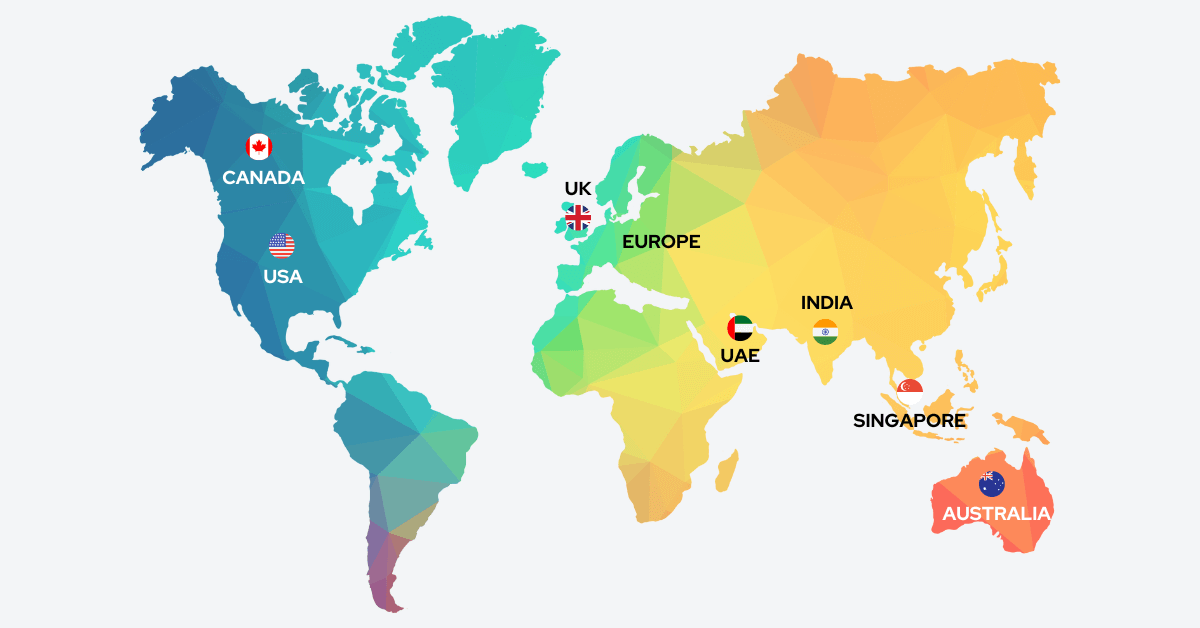
USA & Canada
UK & Europe
What are the Applications of Point Cloud to 3D Model Conversion?
There are a variety of applications of point cloud to 3d model conversion. These applications highlight the transformative power of point clouds in revit modeling. The application is a more data-driven approach to design, construction, and lifecycle management.
Mentioned below are the stage-wise distribution of the application of Point Cloud Modeling:
1. Design Development
Point cloud to BIM is quite useful for developing designs and BIM models of existing building structures.
Many building owners find it difficult to gather the blueprints or plans of an old building that requires demolition and renovation.
Scan to 3D Revit Model plays a significant role not only in developing 2D CAD drawings of the built asset but also in promoting collaboration between different design stakeholders.
Mentioned below are some of the common applications of Point Cloud to BIM in Design Development:
2. Site Assessment
Point clouds capture the exact geometry of existing buildings and structures. By importing a Point Cloud into Revit, BIM Modelers can precisely model the existing design elements. This information is critical for renovations, restoration, and adaptive reuse projects.
The design elements modeled in Revit typically include:
3. Facilities Management
Point cloud to 3D Revit model allows BIM engineers to develop As-built 3D models that capture lifecycle and facilities designs.
This model is powerful for facilities management and planning potential future renovations.
- Using Point Cloud to BIM in facilities management eliminates guesswork and allows facilities managers to access required information in the building directly through the BIM model.
- Additionally, having an as-built Revit model using Point Cloud allows the design team to tag the design elements with the required information and generate shop drawings/sheet work. These drawings are easily extracted and developed, saving a lot of time as compared with the traditional ways,
What are the Best Practices for Point Cloud to 3D Revit model conversion?
1. Data Acquisition and Review
Converting a Point Cloud to 3D Model has many different applications. Therefore, it is important to understand the purpose, quality, and completeness of the point cloud data from the sharing party whether they are required for design development, site assessment, or facilities management.
If the quality or the completeness of the scans are not up to the expectations then it is good to request for additional scans from the scanning professionals.
2. Clean and Registered Point Cloud Data
Often laser scanning professionals provide clean data that is noise-free and removes irrelevant objects.
If you have the raw data then you can use point cloud processing software such as Recap Pro to remove the noises, outliners, and irrelevant objects.
It is critical to pay attention to the areas with potential registration challenges. This includes repetitive patterns and occlusions.
3. Choose Suitable File Formats
For effective Point Cloud to 3d Revit modeling, it is important to choose the Point Cloud format that is compatible with Point Cloud processing software and Revit.
Often formats such as IMP are not importable in Autodesk software and need to be converted into suitable formats such as RCP or E57. Always consider factors such as data richness, file size, and software compatibility.
For instance, E57 offers a good balance between data richness and simplicity while RCP is more convenient for Recap Pro users.
4. Coordinate System Management
Coordinates play a significant role in maintaining the right location of the design elements in the Revit model using point cloud data.
It is imperative to check that the point cloud data uses the same coordinate system as your Revit model. If not, use features offered by Revit to transform the point cloud to the correct system.
5. Revit Model Verification and Quality Assurance
It is a good practice to divide the scope of work into parts and constantly compare your Revit model progress with the point cloud data to make sure that the model is accurate.
To identify discrepancies, BIM modelers use section cuts and 3D views to closely review the doubtful areas that need more attention.
Our Most Watched YouTube Video
Frequently Asked Questions - FAQs
How do you make a 3D model from point cloud?
To create a 3D model from a point cloud, you’ll need specialized software like Autodesk Recap or CloudCompare. Import the point cloud data, clean it by removing outliers, and then use algorithms like surface reconstruction to convert points into a 3D mesh, resulting in a detailed 3D model.
Why convert point cloud to mesh?
Converting a point cloud to a mesh enhances visualization and analysis. Meshes offer solid surfaces and textures, making it easier to work with 3D data in various applications like 3D printing, gaming, and architectural design.
What is the difference between 3D model and point cloud?
A 3D model is a solid, visually detailed representation of an object, while a point cloud is a collection of data points in 3D space, lacking surfaces or textures. Models are more visually appealing, while point clouds are raw data used for analysis and reconstruction.
What can you do with a point cloud in Revit?
In Revit, you can import a point cloud to aid in precise building modeling and renovation. It serves as a reference, allowing you to align elements accurately, verify existing conditions, and enhance the overall accuracy and efficiency of your BIM (Building Information Modeling) projects.
How does point cloud data benefit BIM projects?
Point cloud data provides precise measurements and visual representation, ensuring accurate BIM models that reflect real-world conditions.
Is point cloud to BIM conversion suitable for all projects?
While beneficial for many projects, it’s especially valuable for complex designs, renovations, and historical preservation.
How does converting point cloud data to 3D model revit improve project efficiency?
Point cloud data reduces errors, streamlines decision-making, and minimizes rework, ultimately saving time and resources.
Are there any limitations to point cloud to BIM conversion?
The process can be time-consuming, and the accuracy depends on the quality of the initial scan.
What are the software requirements to convert point cloud to 3d model?
You’ll need Autodesk Recap Pro and Revit software to complete the conversion process.
Where are you providing converting point cloud to 3d model revit services in USA?
California, Texas, New York, Florida, Illinois, Pennsylvania, Ohio, Georgia, New Jersey, Washington, North Carolina, Massachusetts, Virginia, Michigan, Maryland, Colorado, Tennessee, Indiana, Arizona, Minnesota, Wisconsin, Missouri, Connecticut, South Carolina, Oregon, Louisiana, Alabama, Kentucky, Utah, Iowa, and many more.
Where are you providing point cloud to 3d model revit services in UK?
London, South East, North West, East, South West, Scotland, West Midlands, Yorkshire and The Humber, East Midlands, Wales, North East, Northern Ireland.
Where are you providing converting point cloud to 3d model revit services in UAE?
Abu Dhabi, Dubai, Sharjah, Ajman, Umm Al-Quwain, Ras Al-Khaimah, Fujairah
Where are you providing converting point cloud to 3d model revit services in Germany?
North Rhine-Westphalia, Bavaria, Baden-Württemberg, Lower Saxony, Hesse, Berlin, Rhineland-Palatinate, Saxony, Hamburg, Schleswig-Holstein, Brandenburg, Saxony-Anhalt, Thuringia, Mecklenburg-Vorpommern, Bremen, Saarland.
Where are you providing converting point cloud to 3d model revit services in Switzerland?
Zurich, Berne / Bern, Lucerne, Uri, Schwyz, Obwald / Obwalden, Nidwald / Nidwalden, Glarus, Zoug / Zug, Fribourg / Freiburg, Soleure / Solothurn, Basle-City / Basel-City / Basel-Stadt, Basle-Country / Basel-Country / Basel-Landschaft, Schaffhouse / Schaffhausen, Appenzell Outer-Rhodes / Appenzell Ausserrhoden, Appenzell Inner-Rhodes / Appenzell Innerrhoden, St. Gall / St. Gallen, Grisons / Graubünden, Argovia / Aargau, Thurgovia / Thurgau, Ticino / Tessin, Vaud, Wallis / Valais, Neuchâtel, Geneva, Jura.
Related Posts
Our Recent Point Cloud / Scan to BIM-Revit Projects
Share Via
Tags
- convert point cloud to 3d model revit, convert point cloud to 3d revit model, convert point cloud to revit model, point cloud data to 3d model, point cloud scan to bim, point cloud to bim, point cloud to revit model, revit point cloud, revit point clouds, scan to bim, scan to bim revit, Scan to BIM Services

Devashish Sharma
Devashish is Founder/Director at Cresire where he leads BIM services. He holds a bachelor’s degree in Civil Engineering from the University of Sheffield and an MSc in Construction Project Management from The University of the West of England. His vision behind CRESIRE is to provide BIM services, adhering to best practices and procedures, to global customers, helping customers to save extensive production costs and overruns.


